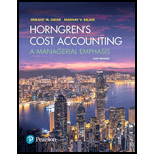
REVEL for Horngren's Cost Accounting: A Managerial Emphasis -- Access Card (16th Edition) (What's New in Accounting)
16th Edition
ISBN: 9780134789705
Author: Srikant M. Datar, Madhav V. Rajan
Publisher: PEARSON
expand_more
expand_more
format_list_bulleted
Concept explainers
Textbook Question
Chapter 17, Problem 17.8Q
Describe the distinctive characteristic of FIFO computations in assigning costs to units completed and to units in ending work in process.
Expert Solution & Answer
Learn your wayIncludes step-by-step video

schedule01:26
Students have asked these similar questions
What is the break even point in sales provide answer
help me to solve this questions
General accounting
Chapter 17 Solutions
REVEL for Horngren's Cost Accounting: A Managerial Emphasis -- Access Card (16th Edition) (What's New in Accounting)
Ch. 17 - Give three examples of industries that use...Ch. 17 - In process costing, why are costs often divided...Ch. 17 - Explain equivalent units. Why are equivalent-unit...Ch. 17 - What problems might arise in estimating the degree...Ch. 17 - Name the five steps in process costing when...Ch. 17 - Name the three inventory methods commonly...Ch. 17 - Describe the distinctive characteristic of...Ch. 17 - Describe the distinctive characteristic of FIFO...Ch. 17 - Prob. 17.9QCh. 17 - Identify a major advantage of the FIFO method for...
Ch. 17 - Identify the main difference between journal...Ch. 17 - The standard-costing method is particularly...Ch. 17 - Why should the accountant distinguish between...Ch. 17 - Transferred-in costs are those costs incurred in...Ch. 17 - Theres no reason for me to get excited about the...Ch. 17 - Assuming beginning work in process is zero, the...Ch. 17 - The following information concerns Westheimer...Ch. 17 - Sepulveda Corporation uses a process costing...Ch. 17 - Penn Manufacturing Corporation uses a...Ch. 17 - Kimberly Manufacturing uses a process-costing...Ch. 17 - Equivalent units, zero beginning inventory....Ch. 17 - Journal entries (continuation of 17-21). Refer to...Ch. 17 - Zero beginning inventory, materials introduced in...Ch. 17 - Weighted-average method, equivalent units. The...Ch. 17 - Weighted-average method, assigning costs...Ch. 17 - FIFO method, equivalent units. Refer to the...Ch. 17 - FIFO method, assigning costs (continuation of...Ch. 17 - Operation costing. The Carter Furniture Company...Ch. 17 - Weighted-average method, assigning costs....Ch. 17 - FIFO method, assigning costs. 1. Do Exercise 17-29...Ch. 17 - Transferred-in costs, weighted-average method....Ch. 17 - Transferred-in costs, FIFO method. Refer to the...Ch. 17 - Operation costing. Egyptian Spa produces two...Ch. 17 - Standard-costing with beginning and ending work in...Ch. 17 - Equivalent units, comprehensive. Louisville Sports...Ch. 17 - Weighted-average method. Hoffman Company...Ch. 17 - Journal entries (continuation of 17-36). Required...Ch. 17 - FIFO method (continuation of 17-36). 1. Do Problem...Ch. 17 - Transferred-in costs, weighted-average method...Ch. 17 - Transferred-in costs, FIFO method (continuation of...Ch. 17 - Weighted-average method. McKnight Handcraft is a...Ch. 17 - FIFO method (continuation of 17-41). 1. Complete...Ch. 17 - Transferred-in costs, weighted-average method....Ch. 17 - Transferred-in costs, FIFO method. Refer to the...Ch. 17 - Standard costing, journal entries. The Warner...Ch. 17 - Multiple processes or operations, costing. The...Ch. 17 - Benchmarking, ethics. Amanda McNall is the...
Additional Business Textbook Solutions
Find more solutions based on key concepts
Communication Activity 9-1
In 150 words or fewer, explain the different methods that can be used to calculate d...
Horngren's Financial & Managerial Accounting, The Financial Chapters (Book & Access Card)
Risk Premiums and Discount Rates. Top hedge fund manager Sally Buffit believes that a stock with the same marke...
FUNDAMENTALS OF CORPORATE FINANCE
(Preferred stock valuation) What is the value of a preferred stock when the dividend rate is 16 percent on a $1...
Foundations Of Finance
The flowchart for the process at the local car wash. Introduction: Flowchart: A flowchart is a visualrepresenta...
Principles of Operations Management: Sustainability and Supply Chain Management (10th Edition)
Horizontal analysis(Learning Objective 2)15-20 min. What were the dollar and percentage changes in Fesslers Fin...
Financial Accounting, Student Value Edition (5th Edition)
The present value of the future earnings. Introduction: The present value is an amount that an individual has t...
Corporate Finance (4th Edition) (Pearson Series in Finance) - Standalone book
Knowledge Booster
Learn more about
Need a deep-dive on the concept behind this application? Look no further. Learn more about this topic, accounting and related others by exploring similar questions and additional content below.Similar questions
arrow_back_ios
SEE MORE QUESTIONS
arrow_forward_ios
Recommended textbooks for you
 Principles of Cost AccountingAccountingISBN:9781305087408Author:Edward J. Vanderbeck, Maria R. MitchellPublisher:Cengage Learning
Principles of Cost AccountingAccountingISBN:9781305087408Author:Edward J. Vanderbeck, Maria R. MitchellPublisher:Cengage Learning College Accounting, Chapters 1-27AccountingISBN:9781337794756Author:HEINTZ, James A.Publisher:Cengage Learning,Principles of Accounting Volume 2AccountingISBN:9781947172609Author:OpenStaxPublisher:OpenStax College
College Accounting, Chapters 1-27AccountingISBN:9781337794756Author:HEINTZ, James A.Publisher:Cengage Learning,Principles of Accounting Volume 2AccountingISBN:9781947172609Author:OpenStaxPublisher:OpenStax College

Principles of Cost Accounting
Accounting
ISBN:9781305087408
Author:Edward J. Vanderbeck, Maria R. Mitchell
Publisher:Cengage Learning

College Accounting, Chapters 1-27
Accounting
ISBN:9781337794756
Author:HEINTZ, James A.
Publisher:Cengage Learning,

Principles of Accounting Volume 2
Accounting
ISBN:9781947172609
Author:OpenStax
Publisher:OpenStax College
Cost Classifications - Managerial Accounting- Fixed Costs Variable Costs Direct & Indirect Costs; Author: Accounting Instruction, Help, & How To;https://www.youtube.com/watch?v=QQd1_gEF1yM;License: Standard Youtube License